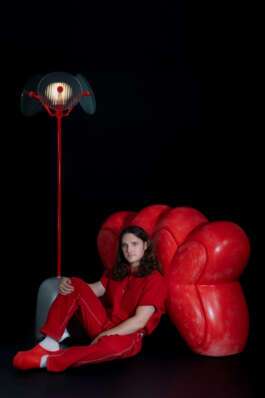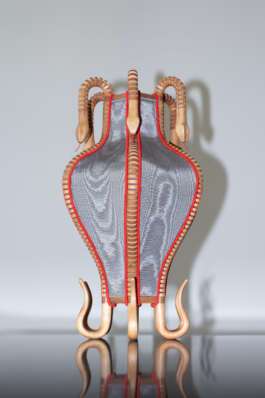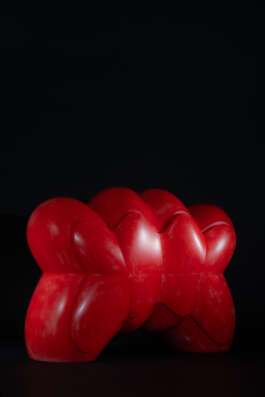



© Sahra Jajarmikhayat
COLLECTIBLE In-Depth
Caleb Ferris
August 2024
This series, COLLECTIBLE In-Depth, unveils the backstage of contemporary creation. Tackling various topics from personal designer processes to the position of collectible design on the global design market, COLLECTIBLE In-Depth offers different views to suit all tastes. Today we speak with Caleb Ferris.
C: Can you talk about a new piece/collection that you’re releasing for COLLECTIBLE this year?
Caleb Ferris: For COLLECTIBLE New York 2024, I’m presenting "Don’t Wanna Know," an architectural column made from ebonized red oak with carved maple appliqués. Inspired by the fast-paced life of New York City, this piece captures the tension between curiosity and the instinct to avoid the unknown. It marks my first showing in New York City as a New Yorker, making it a significant milestone for me. This column playfully explores how we navigate the city’s relentless energy and the structures—both physical and emotional—we create to keep moving forward.
C: How does your approach to contemporary collectible design reflect current cultural or societal trends?
CF: My approach to collectible design often mirrors the desire for playfulness and a departure from overly serious design narratives. However, while there’s a theoretical desire for boldness, people often gravitate toward safer, more familiar choices. For instance, recent paint swatches like "accessible beige" and "agreeable gray" reflect a broader trend toward comfort and familiarity. In a world of constant uncertainty and rapid change, my work aims to invite viewers to find joy in the everyday, encouraging a light-hearted engagement with their surroundings and inspiring them to take creative risks.
C: How did you get into collectible design? Why did you focus your practice on this type of design rather than industrial design?
CF: After spending over a decade working as an industrial designer for large corporations, I found myself creating products that aligned with someone else’s vision. Realizing I’d lost touch with my own creative voice, I launched my first collection in 2023, inspired by pasta forms—something I would never design in my day job. Transitioning into collectible design felt like a natural progression, offering me the freedom to create work that is both personal and expressive.
C: When designing a collectible object, how do you think about its various environments where it can end up?
CF: I often reflect on how we’re living in the future, yet our current environments don’t quite match that reality. Looking at science fiction and movies, I see how far we’ve drifted from our imagined visions of the future. While I’m not suggesting we all adapt to a Jetsonian fantasy, much of my work draws inspiration from both the past and present. I believe in moving forward while keeping in mind the lessons from our past. I dream about spaces that blend past, present, and future—experimenting with new ideas while remembering the places we’ve been.

© Caleb Ferris

© Sahra Jajarmikhayat

© Sahra Jajarmikhayat
COLLECTIBLE In-Depth
Caleb Ferris
August 2024
This series, COLLECTIBLE In-Depth, unveils the backstage of contemporary creation. Tackling various topics from personal designer processes to the position of collectible design on the global design market, COLLECTIBLE In-Depth offers different views to suit all tastes. Today we speak with Caleb Ferris.
C: Can you talk about a new piece/collection that you’re releasing for COLLECTIBLE this year?
Caleb Ferris: For COLLECTIBLE New York 2024, I’m presenting "Don’t Wanna Know," an architectural column made from ebonized red oak with carved maple appliqués. Inspired by the fast-paced life of New York City, this piece captures the tension between curiosity and the instinct to avoid the unknown. It marks my first showing in New York City as a New Yorker, making it a significant milestone for me. This column playfully explores how we navigate the city’s relentless energy and the structures—both physical and emotional—we create to keep moving forward.
C: How does your approach to contemporary collectible design reflect current cultural or societal trends?
CF: My approach to collectible design often mirrors the desire for playfulness and a departure from overly serious design narratives. However, while there’s a theoretical desire for boldness, people often gravitate toward safer, more familiar choices. For instance, recent paint swatches like "accessible beige" and "agreeable gray" reflect a broader trend toward comfort and familiarity. In a world of constant uncertainty and rapid change, my work aims to invite viewers to find joy in the everyday, encouraging a light-hearted engagement with their surroundings and inspiring them to take creative risks.
C: How did you get into collectible design? Why did you focus your practice on this type of design rather than industrial design?
CF: After spending over a decade working as an industrial designer for large corporations, I found myself creating products that aligned with someone else’s vision. Realizing I’d lost touch with my own creative voice, I launched my first collection in 2023, inspired by pasta forms—something I would never design in my day job. Transitioning into collectible design felt like a natural progression, offering me the freedom to create work that is both personal and expressive.
C: When designing a collectible object, how do you think about its various environments where it can end up?
CF: I often reflect on how we’re living in the future, yet our current environments don’t quite match that reality. Looking at science fiction and movies, I see how far we’ve drifted from our imagined visions of the future. While I’m not suggesting we all adapt to a Jetsonian fantasy, much of my work draws inspiration from both the past and present. I believe in moving forward while keeping in mind the lessons from our past. I dream about spaces that blend past, present, and future—experimenting with new ideas while remembering the places we’ve been.

© Caleb Ferris

© Sahra Jajarmikhayat
Contact
info@collectible.design
VIP PORTAL
EXHIBITOR PORTAL
PRIVACY POLICY
© 2025 Collectible
Contact
info@collectible.design
VIP PORTAL
EXHIBITOR PORTAL
PRIVACY POLICY
© 2025 Collectible